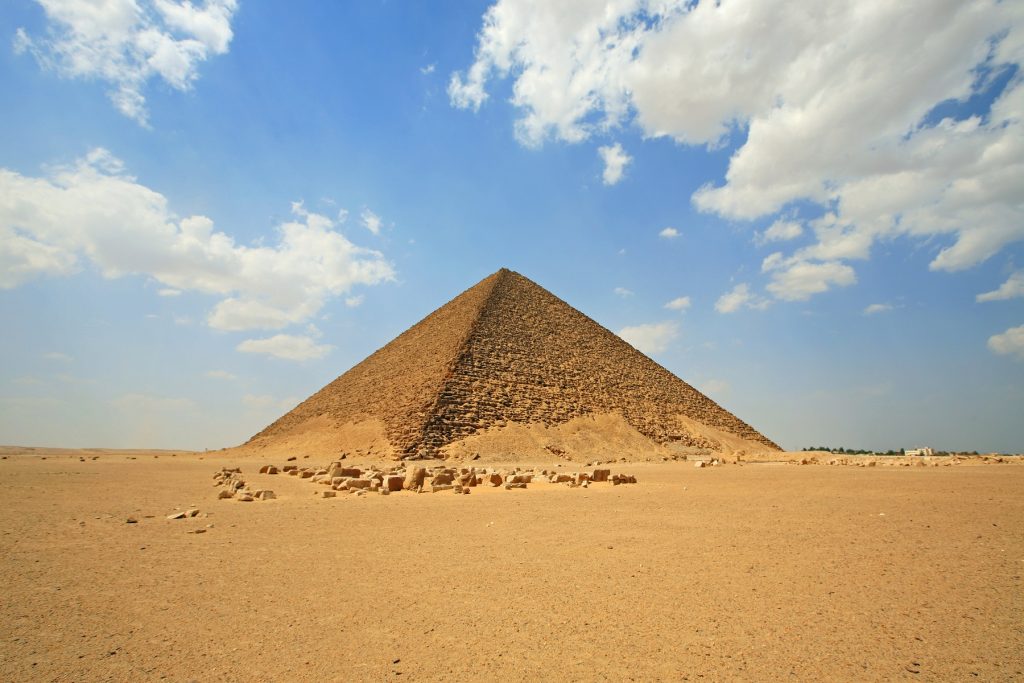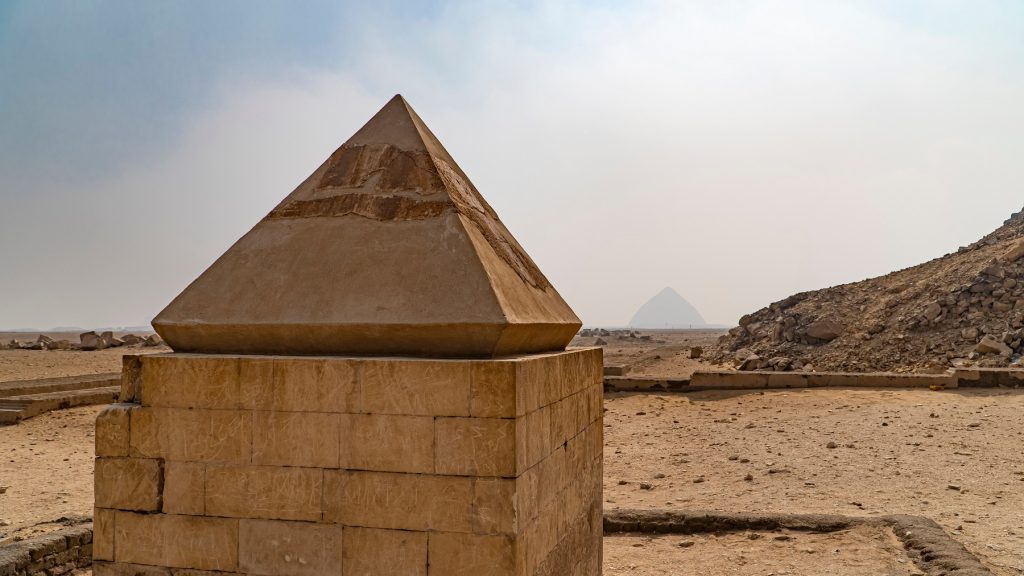- The Red Pyramid is the third-largest pyramid in Egypt with a total volume of 1,694,000 cubic meters (59,823,045 cu ft).
- Believed to have been built around 2,590 by King Sneferu, it is considered the first successful smooth-sided pyramid in Egypt.
There are around 120 pyramids in Egypt. Some of these pyramids date back more than 4,700 years, like Djoser’s Step Pyramid, a structure believed to be the oldest pyramid ever built in the history of Egypt. Djoser’s Pyramid at Saqqara was a revolutionary monument that is thought to have given rise to a pyramidomania that resulted in the construction of some of the most impressive monuments the world has ever seen.
After the completion of the Pyramid at Saqqara, a few generations of rulers attempted in replicating the mind-boggling pyramid complex, evidence of which are the Layered pyramid and the buried pyramid. These attempts were unsuccessful and Egypt was left without any new pyramids until the Fourth Dynasty Reign of King Sneferu.
Pharaoh Sneferu is ancient Egypt’s greatest pyramid builder, having commissioned three pyramids: The Pyramid at Meidum, the Bent Pyramid and Red Pyramid at Dahshur.
What Djoser did during his reign, forever changing Egyptian architecture, Sneferu did even more. While the “invention” of the Step Pyramid is credited to Djoser and his young royal vizier and architect Imhotep, the first successful smooth-sided pyramid is credited to Sneferu and his architects.
If Sneferu did build the pyramid at Meidum and the two stone pyramids at Dahshur, his pyramids alone contain more than 3.5 million cu. meters (124 million cu. ft) of stone. All the other pyramids of Egyptian pharaohs combined, excluding the queen’s pyramids and satellite pyramids) contain no more than 41 percent of the total mass of the pyramids attributed to Sneferu, his Son Khufu and grandson Khafre. This means that the truly gigantic pyramids of Egypt were built over the course of only three generations: Sneferu, Khufu and Khafre. Although Menkaure still used multi-ton stones in the construction of the pyramid, in terms of total volume Menkaure’s pyramid is smaller than the Step Pyramid of Djoser.
The third Pyramid built by Sneferu

The Red Pyramid, also known as the Northern Pyramid, was the third pyramid erected by King Sneferu of the Old Kingdom. Located no more than a kilometer from the Bent Pyramid, the Red Pyramid was a revolutionary structure in more ways than one, and a monument which bears evidence of the perfected workmanship and engineering skills of the pyramid builders.
Being Sneferu’s third pyramid, it is very likely that the builders of the North Pyramid learned much from the pyramid at Meidum and the Bent Pyramid at Dahshur. In other words, everything that may have gone wrong in the design, planning, and construction of the Pyramid at Meidum and the Bent Pyramid was polished out during the planning and design of the Red Pyramid.
The Bent Pyramid probably contributed greatly in the design of the Northern Pyramid as the upper part of the structure was built with the same, shallower 43-degree angle as the upper part of the Bent Pyramid, which suggests that the mistakes made at the Bent Pyramid were corrected in the design and construction of the Red Pyramid. Egyptologists suggest that the design of the Red Pyramid is a direct outcome of the engineering crises that the builders experience during the construction of the pyramid at Meidum, and the Bent Pyramid.
Mainstream Egyptologists argue that the construction of the pyramid was started during the thirteenth year of the reign of Sneferu, around 2,590 BC. however, there isn’t a consensus among experts as to how long it took for the pyramid to be completed. Some Egyptologists like Rainer Stadelmann suggest that the pyramid was built in around 17 years, while John Romer suggests it took the ancient Egyptians no more than 10 years to build the pyramid. Whatever the case, the constitution for the Red Pyramid marked another revolutionary step in the Egyptian pyramid building history.
Sneferu’s Red Pyramid presently measures 105 meters high, and a rare pyramidion is thought to have once stood atop the pyramid. One such capstone was found near the pyramid and was reconstructed by scholars; it is now on display at a local museum but it remains unclear whether the pyramidion belonged to the Red Pyramid since its angle of inclination differs from that of the pyramid.
The Red Pyramid is regarded as ancient Egypt’s first successful attempt at building a true smooth-sided pyramid. The pyramid is referred to locally as the Bat Pyramid. Once completed, the monument was cased with highly polished white Tura limestone of which only a few pieces remained present at the pyramid’s base, at the corners. It has a base of 105 metres (344 ft) (200 cubits) by 220 meters (722 ft) (420 cubits), and a total estimated volume of 1,694,000 cubic metres (59,823,045 cu ft). Since the pyramid was cased with white Tura limestone, it wasn’t always red. However, during the Middle Ages, much of the limestone was taken from the pyramid and re-used in the construction of other buildings near Cairo, eventually exposing the red, limestone core beneath.

The entrance to the pyramid is located high on the northern side, and a tunnel 3 feet (0.91 m) in height and 4 feet (1.2 m) wide, takes the visitor down at 27 degrees for approximately 200 feet (60 meters) to a short horizontal passage that leads into a chamber whose impressive, corbelled roof is 40 feet (12 m) high and rises in eleven intricately built steps.
Another chamber is located to the south of the pyramid, accessed through a short horizontal passage which was closed down at one time, probably meant to act as a kind of defense mechanism that may have confused potential intruders, Egyptologists explain. The second chamber is similar to the first and was built right beneath the center of the pyramid.
A third chamber is accessed through an entrance located high in the southern wall which gives onto a short horizontal tunnel that takes us to the third and final chamber of the pyramid which has a corbelled roof 50 feet (15 m) high.
Although the Red Pyramid of Sneferu was his most impressive pyramid, and despite the fact it was supposedly said to serve as a tomb, the Pharaoh’s body has never been discovered by Egyptologists.
Being the first successful smooth-sided pyramid, Sneferu’s ancient wonder directly influenced future pyramid building-techniques and most likely laid down the necessary foundations for the construction of the great Pyramid of Giza, thought to have been built some 4,500 years ago by Sneferu’s Son and heir to the throne, Khufu.

